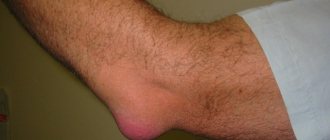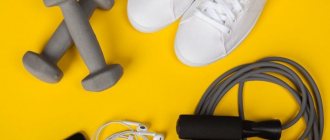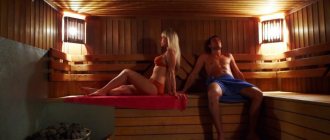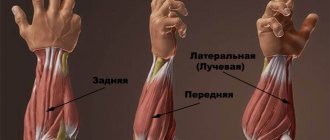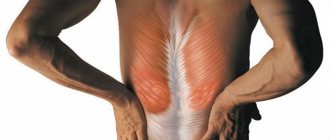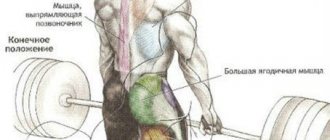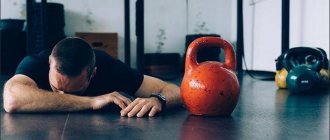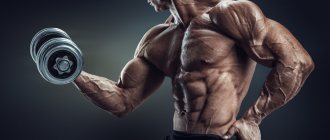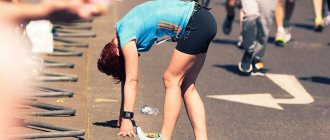Pain after training
Explanations for why arm muscles hurt after training should be sought in the peculiarities of the human body. The main cause of muscle soreness is the formation of lactic acid, which is formed as a result of the breakdown of glucose occurring in the tissues. Such chemical reactions begin to occur in tissues during intense training, when muscle fibers require additional energy to perform exercises and receive it by breaking down glucose.
As a result, during a set of exercises, a large amount of lactic acid accumulates in the muscles, which does not have time to be washed out. As a result of its impact on the fibers, a person begins to experience burning and pain.
In some cases, a person may experience trembling. Discomfort in the arm muscles may continue for several hours. Due to the anatomical features of the body, in order to quickly get rid of pain in the arm muscles, it is necessary to increase blood circulation immediately after training.
What to do if your arm muscles hurt after training:
- do sets of stretching exercises;
- take a shower with warm water;
- resort to massage;
- drink a couple of glasses of warm water.
After following the above recommendations, lactic acid will be eliminated faster and the pain will go away.
Why do I have discomfort in my hands after training? 5 most common problems
If you have never trained, then after the first workout there is always pain and discomfort in the muscles. But after several regular workouts, the body adapts to the stress, and the discomfort disappears.
However, it often happens that some time after training you may feel discomfort in the muscles of your arms. They can manifest themselves in different ways. Let's look at the most common problems.
See also: 3 reliable methods for training your hands with an expander How to strengthen your fingers at home?
Feeling pain
My arms hurt after training, what should I do and what is the reason for this? Muscle pain can be due to natural causes, or it can be traumatic in nature. Natural reasons are:
- If you started training after a long break;
- We began to master new levels of loads;
- We started training for the first time, but the body did not adapt to the training.
- Pain occurs due to microtrauma of the muscles and the resulting inflammation.
Regular exercise is the best pain prevention! By the nature of the pain that occurs, you can understand the cause of its occurrence. Quite severe and constant pain most often indicates excessive and unbalanced stress. In this case, experienced trainers recommend performing all the usual exercises, but reducing the weight by half.
Post-traumatic pain, especially in the crooks of the wrists, makes it difficult to continue exercising and may worsen some time after training. This usually happens with a bad warm-up. Stop the exercise, rest the injured limb, and apply ice.
Pain that manifests itself as a burning sensation indicates that your muscles are being well worked out. This sensation is caused by lactic acid, which is excreted some time after the end of the workout.
Many people believe that pain after exercise is a good indicator. In fact, this is not the case, although moderate pain is considered acceptable in some cases.
You need to strive for pleasant fatigue in the muscles, to increase those indicators that you focus on (muscle girth, burning fat deposits, giving relief to those areas where your load is emphasized, etc.)
Massage and self-massage helps improve blood circulation, eliminate pain and muscle spasms.
We also recommend watching the video:
Caution! If you increase the load gradually, the body has time to get used to it and strengthen the muscles, ligaments and joints. Particular attention should be paid to the condition when the pain is caused by injury. The nature of the pain changes from stifling to acute. It can occur while performing the exercise or some time later.
Do not straighten at the elbow
Pain often occurs when bending the limb in the hand or in the elbow joint. Why don't my arms straighten after training? The reasons can be very different:
1. Load limit exceeded. A muscle spasm occurs, as a result of which the blood supply is disrupted and a lack of oxygen occurs. The muscle cannot contract, normal blood flow is disrupted, and lactic acid accumulates. Most often, it hurts to bend your arm at the elbow joint after biceps exercises.
Recovery usually takes place within ten days on average. Usually in this case, a special therapeutic restorative massage helps, which relieves spasm and restores normal blood flow;
2. Receiving microscopic injuries to muscle tissue. This happens when the muscles are not warmed up well enough before training. This is also facilitated by sudden movements, in which muscle fibers are forced to contract very quickly. In this case, the ligaments are sprained and are not ready for extreme stress. The reason for this could be, for example, a sharp rise in the barbell.
Special types of restorative massage give good results. By affecting muscles and tendons, it relieves pain and spasm, improves blood flow. A contrast shower is also useful, which must begin with a hot douche and end with a cold one, in the direction from bottom to top;
3. The formation of a slight dislocation of the wrist joint , occurring due to injury to the ligaments. It usually forms against the background of frequent sprains of the ligaments and tendons of the hand. Recovery requires rest and the use of salt compresses.
Dissolve two teaspoons of salt in one glass of water. We wet the towel, wring it out well and place it on the sore joint. On top is a dry towel folded in several layers. We do not use polyethylene; the fabric must ventilate naturally. This procedure must be done at night for a week.
In the future, you need to dose the load to avoid such injuries. During the recovery period, special exercises that the instructor can select for you individually are helpful. Recovery should be given the greatest attention, since if rehabilitation procedures are not followed, injuries can recur.
We recommend watching a useful video on this topic:
See also: 10 useful properties of the wrist expander Effective methods of strengthening the wrists
Tremor
Why do my hands shake after training? Many factors can lead to this problem:
- Hunger, unbalanced diet;
- Severe fatigue, anxiety;
- Lack of night rest;
- Heavy physical activity;
- Incorrectly calculated exercise load.
Everyone has managed to encounter such troubles: hands shake after some time after severe muscle tension. This occurs when the natural alternation of muscle tension and relaxation is disrupted . For example, after the usual load has been increased, and the body has not yet had time to adapt to it.
In this case, it is necessary to take herbal remedies, such as valerian. Reduce the intensity of training for a while and take time to rest. If this does not help, you need to consult a doctor who, after examination, will give you recommendations and prescribe vasodilators and anticonvulsants.
If your problem is an unbalanced diet , you need to enrich your diet with proteins, carbohydrates, vitamins and minerals. Your diet must include fish, chicken, dairy products, herbs, and vegetables.
Learn more from the video:
See also: 5 proven exercises for arms with dumbbells Exercises for arms for every day
Swelling
Is your hand swollen after playing sports? This problem is familiar to many who, at the beginning of training, sought to quickly increase loads. The reasons are most often the following:
- The body does not have time to adapt to the rate of increase in loads. In this case, first of all, the ligamentous apparatus, as well as the muscles, suffer;
- Unbearable loads lead to sprains, tissue swelling and pain. If you have a sharp pain, and after a while your hand begins to swell, this indicates an injury.
- Joint disease can also cause swelling after exercise, so you will most likely need to consult a doctor;
In most cases, the hands become swollen after training due to the appearance of lactic acid. Fitness instructors recommend the use of warm baths with the addition of sea salt, contrast showers, bath procedures with a broom and self-massage techniques. Light gymnastic exercises will also be very useful in this case.
At the next workout, it is recommended to reduce the load and bring it to comfortable limits. In the future, increase it gradually, monitoring your well-being. Performing tension and relaxation exercises gives very good results, helps relieve tension and eliminate hand tremors.
If there is a suspicion of a sprain or rupture of the ligaments, it is necessary to apply cold, fix the hand motionless and consult a doctor. If it is a sprain, it will go away in a week. But a more serious injury can occur - a ligament rupture, and swelling in this case is its first sign;
For more information about this condition, watch the video:
Numbness
The reasons why your hands go numb after exercise may include the following:
- When performing exercises, the arms are raised higher than the level of the heart;
- Lack of B vitamins , for this reason the transmission of nerve impulses may be disrupted;
- Constant monotonous load on the limbs when the hand is tense;
- Dystrophic changes in the spine due to osteochondrosis, resulting in pinched nerves and compression of blood vessels;
- Vertical position of the limb when performing a certain type of physical exercise;
- Incorrectly selected set of exercises;
- Immobility of a limb associated with working at a computer;
- Intense sports training, which can cause damage to the heart and blood vessels;
Watch the video for more details:
Caution! If your left arm goes numb, this may be a sign of heart disease, so you should consult a doctor!
In all cases, it is necessary to determine the cause of numbness and eliminate it. If the reason is intense physical activity, you need to reduce the number of exercises and increase the time for rest and relaxation between approaches.
What is the reason for the pain after a day?
For untrained athletes, the feeling of severe pain in the arm muscles after training can last a long time and the recovery process can take several days, while the pain can be very disturbing and every movement can be difficult. Such pain is of a different nature and in the sports environment is called delayed. In this case, the muscles ache for an average of 1 to 3 days.
The reason for such sensations is the appearance of microtraumas of muscle fibers, which appear in a person after performing exercises with a serious load. In the process of their stretching and contraction, tiny microscopic tears are formed; they do not cause pain immediately after training. After 24 hours, such places begin to become inflamed and painful.
If the muscles hurt and the sensations are associated with delayed symptoms, then such pain should not be a source of anxiety and worry, it is a natural reaction of the body to overexertion. The body perceives stress from physical activity and the ongoing redox processes as a reason for a response, so the muscles hurt.
Methods for relieving muscle pain
On average, it takes 48 hours for scarring, complete healing and fiber restoration to occur. It is recommended to do the following:
- do a soft tissue massage; hydromassage should be avoided;
- take a warm bath with sea salt or essential oils for 15 minutes;
- resort to physical exercise;
- take advantage of bathing procedures in the form of a visit to the Finnish sauna;
- ensure sufficient sleep time, since recovery processes occur during the period of muscle rest;
- provide the body with a sufficient amount of “building” materials in the form of proteins, carbohydrates, vitamins and minerals;
- arrange a bath procedure.
If the muscles hurt severely and the symptoms become impossible to tolerate, then you can use an ointment or gel with an anti-inflammatory effect.
The most popular for pain relief is the use of Voltaren or Emulgel with a dosage of active ingredients in an amount of 1%. Even if the muscles hurt badly, sports experts do not recommend resorting to taking pharmacological drugs. In case of increased body temperature and severe symptoms of overexertion, you can take Ibuklin in accordance with the dosage indicated in the instructions for the drug. The drug has anti-inflammatory, analgesic, antipyretic effects and belongs to the category of non-steroidal drugs. It is recommended to resort to ointments and medications only in extreme cases.
About restoring the body after training >>
The last recommendation, in the form of the need for physical activity when muscles hurt, often causes a little surprise among novice athletes. In fact, performing a set of exercises allows you to increase blood flow in sore areas and promotes better nutrition of inflamed tissues, as a result of which the healing process is faster. This recommendation should not be used for several hours after training, since the muscles need time for basic recovery.
You should not use exercises with serious power load; to relieve pain symptoms, it is enough to perform a set of warm-up exercises. Anaerobic exercise is considered to be the most effective for removing lactic acid, so it is recommended to jog at a slow pace for 5-10 minutes, after which it is recommended to do stretching exercises.
Therapy
Treatment methods depend on the diagnosis:
- If necessary, elbow immobilization can be performed.
- In case of severe pain, a joint block is performed.
- Non-steroidal anti-inflammatory drugs are prescribed to relieve inflammation and relieve pain.
- Physiotherapeutic procedures are actively used (massage, various methods of traction, mechanotherapy, etc.).
- Surgical intervention is practiced when bone fragments have not healed properly or rough scars have formed that impede free movement. The nature of the operation is determined by the type and severity of the pathology. In especially severe cases, joint replacement is practiced.
During the recovery period, regular exercise of the joint will be useful. A set of exercises will be selected by a specialist in physical therapy.
Even if you have minor problems with elbow movements, you should not hesitate to visit a medical facility. Delay can result in joint degradation with a concomitant deterioration in quality of life.
More information about the anatomy of the elbow can be obtained from the video:
You can learn about exercises for elbow epicondylitis by watching the following video:
Similar:
- Methods of treatment for a fracture of the elbow joint, causes and symptoms of injury, rules of rehabilitation
- Review of the most common elbow diseases, their symptoms and treatment
- Under what conditions do cracks appear in the elbow joint, symptoms and organization of effective recovery
- Symptoms of dislocation in the elbow area, basic treatment methods, causes of pathology, prevention and prognosis
- Treatment and restoration of the elbow after a fracture of the radial head
- Diseases that cause pain in human elbow joints, a list of causes and symptoms
- What to do if the joint in the knee area does not bend completely
Pain due to injury
This type of pain is the most dangerous and requires immediate action. Painful sensations from arm muscle injuries have characteristic symptoms, so a person understands the occurrence of a problem almost immediately. They are characterized by the following features:
- sudden onset of pain;
- localization of a point nature;
- discomfort that does not go away for a long time;
- inability to continue training;
- external changes in the injured area, in the form of swelling, the appearance of an uncharacteristic skin tone, and an increase in its temperature.
Pain from injuries can be intermittent and only appear when the athlete tries to do certain types of exercise. If such signs appear, it is recommended to immediately seek medical help. Experts do not advise delaying visiting a doctor and doing this even if there is a suspicion of an injury to the arm muscles.
Can muscles not hurt?
The normal reaction of the body to a sufficient degree of stress is the appearance of pain, which disappears after a few hours after training. Severe, long-lasting pain in the arm muscles indicates a person’s unpreparedness or an incorrectly chosen training program.
About the causes of malaise during training >>
For beginner athletes, fear of pain after the first classes is one of the common reasons for refusing to exercise. Many people make the mistake of giving themselves a long recovery period after the first workout. A beginner's program should not include training with heavy weights, a large number of sets and repetitions. The purpose of the initial stages is to prepare the muscles for work, restore their tone and endurance.
The human body is designed in such a way that over time the muscles adapt to constant loads and over time, pain in the hands and body after exercise can completely disappear. For training, such a development of events indicates the ineffectiveness of the exercises and means a stop in the process of muscle development. The absence of pain indicates that the fibers are in the comfort zone, which means there is no progress.
Why do muscles hurt after training?
Pain is a reflection of the process during which muscle structures are destroyed. According to a study conducted by Sterlig and Morozov, physical exercise displaces the myofibrils of muscle fibers, mitochondria disintegrate, which provokes an increase in the level of white blood cells in the blood. A similar condition occurs with injuries, inflammation, and infections.
As a result of the destruction of muscle tissue fibers, protein fragments of molecules are formed, and cells that digest damaged tissue, called phagocytes and lysosomes, are activated. They secrete products that cause pain. Muscle fibers, when destroyed, form satellites, which are cells that provoke the production of protein by tissues.
There is another fact that does not raise any doubts, which is that pain during bodybuilding is felt especially acutely only after the first workouts, and then, when they become regular, they are almost no longer felt. If there is a long pause in classes, they appear again.
When training is completed, protein production in the body accelerates, which leads to the accumulation of creatine phosphate in muscle tissue, increasing the level and activating glycolytic enzymes. This process becomes much more efficient over time, and therefore oxidation occurs, which is the source of energy for muscle contractions. The amount of training you do makes it almost impossible for your muscles to deplete their energy source.
Thanks to regular training, the energy potential for the muscles increases, and, consequently, performance indicators with strength. On the other hand, there is a reduction in applied stress and training impact. The reverse reaction is that muscle adaptation slows down. This phenomenon is called a training plateau, when in order to make a breakthrough it is necessary to change the load and training factors, changing splits, rest time between sets, exercises performed using supersets, drops, and so on.



